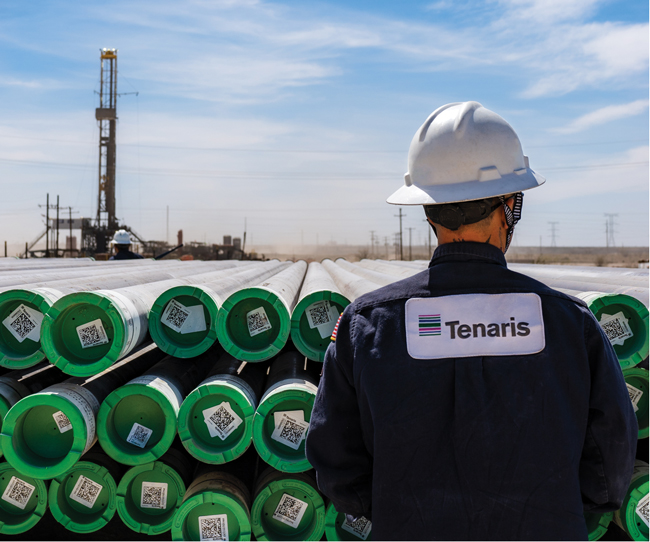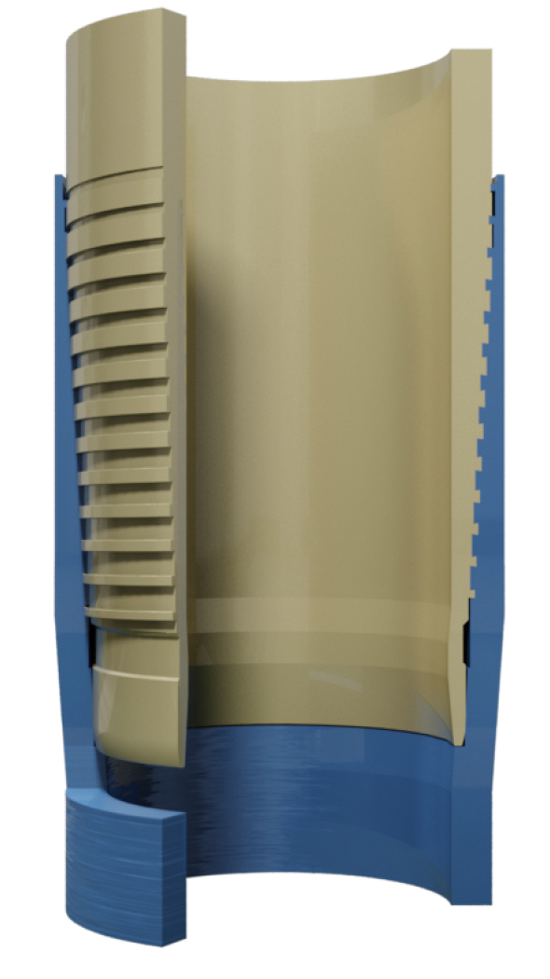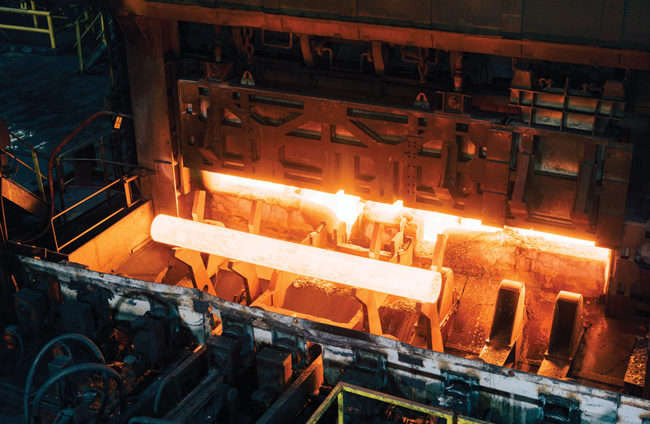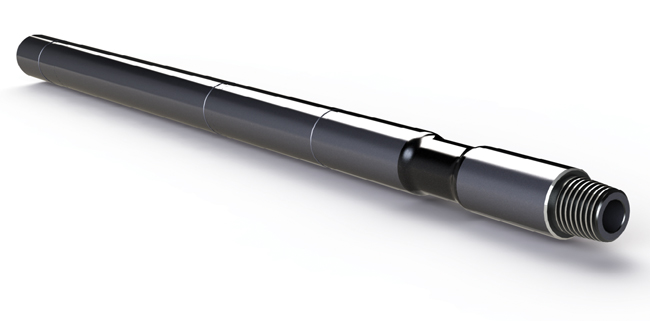
Long Laterals Fuel OCTG Innovations
By Danny Boyd
With well operators challenged to drill longer laterals in harsher downhole environments on slimmer budgets, they are looking for every advantage they can find to minimize downtime and costs. The suppliers of drill pipe, casing and other oil country tubular goods have answered the call by developing connections that excel in harsh environments and deliver strong performance at a lower cost.
Meanwhile, downhole tool manufacturers are refining techniques for getting coiled tubing in and out of longer laterals.
Streamlining logistics can be an extremely effective way to take costs out of well construction, suggests Laura Urrutia, U.S. commercial director at Tenaris. With that truth in mind, the company is partnering with operators to better coordinate pipe manufacturing and delivery schedules.
Through an integrated supply chain program introduced in 2015, clients provide drilling forecasts, Urrutia details. As part of the program, Tenaris’ technical sales team participates in drilling team discussions to support basic string design and optimize the timing of pipe manufacturing and delivery.
The QR codes shown here provide details on each joint’s production history and certification, as well as measurements and weights taken by robots at the mill. Technicians scan the QR codes to create an electronic tally rather than measuring pipe on site, Tenaris describes. The company says this approach saves time, improves safety and reduces errors.
“The whole concept was being able to react faster to a very fast-paced market, and we knew our customers needed this,” Urrutia says.
According to Urrutia, that responsiveness comes in part from Tenaris leveraging its local mills and service centers to synchronize production with delivery. By tying production more closely to operators’ needs, pipe can be delivered to the well site shortly after it’s produced rather than being stored at a yard for extended periods.
The latest enhancement to the supply chain and direct delivery service allows pipe to arrive at the well site ready to be run, Urrutia adds. There is no need to remove storage compounds from the pipe, then add a running compound, because Tenaris uses automated equipment at the mill to apply a proprietary compound that performs both functions. This change can deliver significant time savings, Urrutia reports.
At the mill, Tenaris has installed robots to measure and weigh each joint of casing. As part of the company’s pipe traceability service, the thread protector and the pipe wall include QR codes that contain these measurements, the pipe’s production history and any other necessary certification information, Urrutia mentions.
Tenaris technicians deliver casing ready to run, Urrutia continues. After the pipe is placed on the rack, the technicians scan the QR codes and send an electronic tally to a field superintendent in a predefined format that functions with the customer’s system. This process is faster, safer and more reliable than performing tallying with a tape measure, she reports.
The delivery and prep service means operators no longer need a six-eight person crew to prepare pipe, Urrutia says. She indicates that each joint of pipe is drifted at the mill to ensure inner diameters are correct, rather than being measured at the pipe rack post-delivery to the rig site. The company also offers a drift on the fly, using its own designed drifts delivered for the casing crew to run at the rig site as each pipe is raised on the catwalk. Coupled with other efficiency gains, this improves safety by reducing the amount of pipe handling and the number of people who need to be in critical areas of the rig.
Clients do not have to pay for unused pipe, Urrutia says. Excess pipe is sent back to Tenaris and inspected. Based on pipe condition, the company provides a credit, discounting inspection and handling costs.
Returned pipe tends to be in better condition, Urrutia shares. That is partly thanks to the dual-purpose compound that allows pipe to arrive run ready. In the past, she explains, casing crews had to remove all the thread protectors to clean off the storage compound with water, which could cause rust pitting. Between the thread protectors staying in place and Tenaris taking care of handling, she says the unused pipe is protected from corrosion and potential damage as it makes its way back to the service center.
Affordable Connections
Challenging horizontal wells with ultralong laterals often require connections that combine high torque performance with exceptional sealability, observes Travis Kelley, Hunting Energy Services’ sales and marketing manager for connection technology. “We have introduced a product that can provide gas sealability without some of the cost drivers typically seen in traditional premium connections,” he says.
Hunting Energy Services says this wedge-style connection for high-temperature, high-pressure environments provides extremely high torque capacity and strong performance under tension, compression, bending and torsional loads. According to Hunting, these capabilities have made the connection a popular choice in challenging applications, including some extreme high-pressure gas plays in the Haynesville region.
The cost savings come from pairing a premium wedge-style thread-form with a proprietary thread sealant. The sealant transforms from a viscous, easily applied compound into a solid polymer when it’s isolated from air and exposed to metal, which is exactly what happens when connections are made up, Kelley describes. He says that in its polymer form, the sealant allows the connection to provide gas sealability without a traditional metal-to-metal seal, making it a more cost-effective alternative to other premium offerings.
Kelley adds that the engineering team has optimized the product’s design to streamline production and manufacturing, an accomplishment that helps control costs. Citing its affordability, Kelley classifies the connection as semipremium even though it offers premium performance.
With a connection design that provides high axial efficiencies and a wedge-style thread-form that delivers extremely high torque performance, the connection excels in the most extreme applications, Kelley says. “The strength of this connection comes into play on these really deep, long laterals where the string has to be rotated to get down to bottom and high torque is the name of the game,” he remarks.
Since its launch in 2017, the semipremium wedge connection has built a strong track record, Kelley assures. Today, most of its applications are in the Permian Basin and Haynesville Shale, but it also is supporting operations in the Rocky Mountains and Eagle Ford, he details.
Sizes range from 4.5 inches to 10.75 inches. The connection’s expanded box outer diameter is less than a traditional coupling, significantly reducing drag during installation and making it ideal for slim-hole applications, Kelley reports. Also, the connection design ensures performance under extreme combined loads, he continues, with high tension and compression efficiencies and unparalleled torsional performance.
Last year, Hunting introduced the next evolution of its onshore product offering with a premium wedge-style connection for even higher gas pressures and high-temperature applications. According to Kelley, the new product integrates features from the semipremium connection with technologies from Hunting’s deepwater product line to achieve even higher performance for the most challenging and critical well environments that operators face today.
The premium wedge connection is proving to be especially beneficial for certain extreme high-pressure gas plays in the Haynesville region, Kelley reports.
Rapid Advances
Higher torque requirements continue to drive rapid improvements to semipremium and premium connections, reflects Ryan Schoenhals, senior director of technical sales and sustainability for tubular products at United States Steel Corp (U. S. Steel).
“If we compare the ratings on our current products to the ones from 10 years ago, the increase is almost exponential,” he says. “When it comes to torque performance, we have to keep moving forward to stay ahead of application demands.”
United States Steel Corp. has made several upgrades to its tubular plant in Fairfield, Al., such as installing an electric arc furnace and state-of-the-art vacuum degasser equipment. The company says these upgrades are helping it deliver reliable and affordable tubulars.
Significant investments in state-of-the-art manufacturing processes have supported the company’s progress, says Eugene Lancas, U. S. Steel’s director of marketing for tubular products. As a recent example, he points out that in 2020, the company installed its first electric arc furnace (EAF) in place of a traditional integrated blast furnace at its flagship tubular plant in Fairfield, Al. The Fairfield EAF is the newest one in the United States that is used to produce tubulars rather than other product types, Lancas says. In addition to providing significant environmental benefits, the EAF enhances manufacturing efficiency and reliability, he reports.
The company also equipped the Alabama facility with the latest vacuum degasser equipment, Schoenhals adds. He says this investment enables production of exceptionally clean steels that increase the reliability of the company’s sour service grade offerings.
Thanks in part to consistent and efficient manufacturing, Schoenhals says U. S. Steel is seeing increasing demand for its premium and semipremium wedge connections. He indicates they have the high torque capacity to withstand continual casing string rotation in the Haynesville, Permian and Appalachian basins and the consistent performance to give operators greater flexibility when designing strings.
The semipremium wedge connection has no seal and requires threads to resist any leakage, while the premium version has a dedicated metal-to-metal seal for leak resistance, he notes. In laterals where perforating and fracturing are occurring, connections’ long-term performance matters less and operators generally prefer the semipremium wedge designs. However, Schoenhals says they often favor the premium offering in the vertical section, where its stronger seal helps maintain well integrity.
U. S. Steel continues to develop solutions for wells with tight clearances, Schoenhals comments. Today, he says, it can deliver threaded and coupled products with outside diameters close to those of semiflush integral joint connections to provide higher tension ratings without introducing clearance-related risks.
Enabling Clean Outs
As lateral lengths increase, so does the amount of friction that coiled tubing needs to overcome to clean out casing, says Jeff Whitworth, a Houston-based regional sales manager for Thru Tubing Solutions. To minimize the friction coefficient between the coiled tubing and casing string, the company has a history of developing tools that vibrate the coiled tubing, Whitworth says.
The most recent tool has broken various depth and time records for companies since its introduction in 2020, Whitworth reports. “We still hold clean-out records for several operators as the fastest times in and out of the hole on certain depths,” he remarks.
By vibrating coiled tubing to minimize friction between the tubing and casing, this fourth-generation tool is accelerating clean-outs in long laterals, Thru Tubing Solutions reports. In many applications, the company continues, it has helped operators break their records for clean-out efficiency.
Run on the end of the coiled tubing, the tool vibrates the tubing axially to lower the friction coefficient across the work string, allowing the tubing to be pushed down the casing string, Whitworth describes. He says the tool has reached the end of laterals that are more than three miles long.
Now in its fourth generation, the tool is tuned for maximum coiled tubing vibration while maintaining low operating pressures, he says. Vibration is achieved by creating an oscillating backpressure at a specific frequency and amplitude to impart a hydraulic load on the coiled tubing.
During normal operations, fluid from the surface is pumped down the coiled tubing and circulated back up the casing to remove debris from plugs, sand and other sediment. The upgraded tool is engineered with an open flow path that never closes, Whitworth says, explaining that this allows circulation to continue even if mechanical issues arise.
“When the coiled tubing is in the lateral to clean out debris, the worst thing that can happen is for pumping and circulation to stop, because then debris will settle down in the well and create a potential stuck pipe situation,” Whitworth stresses. “Knowing that, we designed the tool so crews could keep debris moving out of the well regardless of the tool’s condition.”
Like its predecessors, Whitworth says the fourth-generation extended reach tool has been developed with two main goals: lowering the pressure drop across the tool required to operate it and homing in on a more effective frequency to impart maximum axial vibration on the work string.
The tool is being used successfully in unconventional basins across the country, he says, including Bakken wells with challenging casing designs, deep Woodford wells and Permian Basin wells with lateral lengths beyond three miles.
Because there are no elastomers inside the tool, which is made of steel, it does not have temperature or fluid limitations, Whitworth mentions. He adds that it is compatible with nitrogen, which is sometimes pumped simultaneously with water in low-pressure wells to reduce fluid density.
For other great articles about exploration, drilling, completions and production, subscribe to The American Oil & Gas Reporter and bookmark www.aogr.com.










